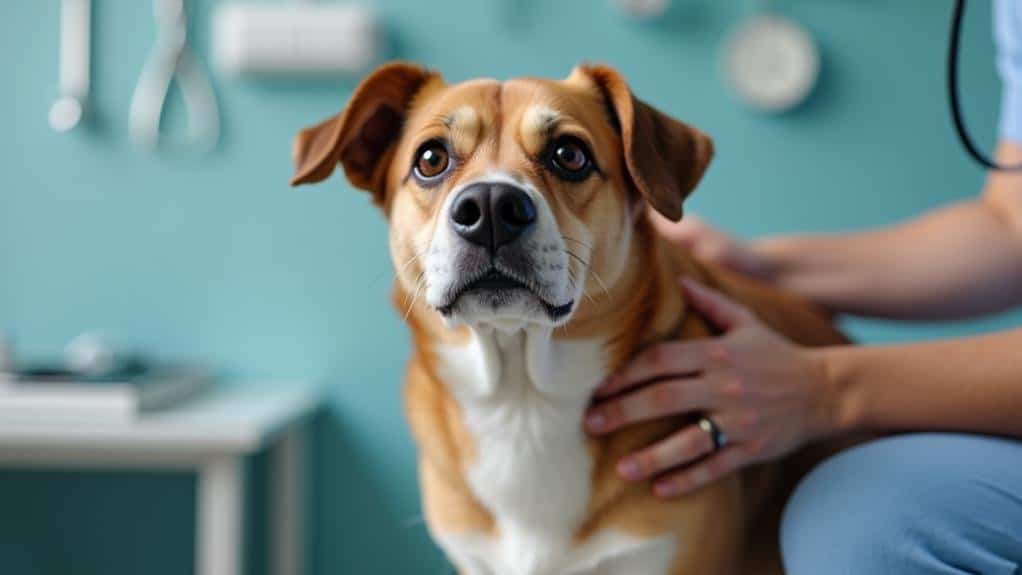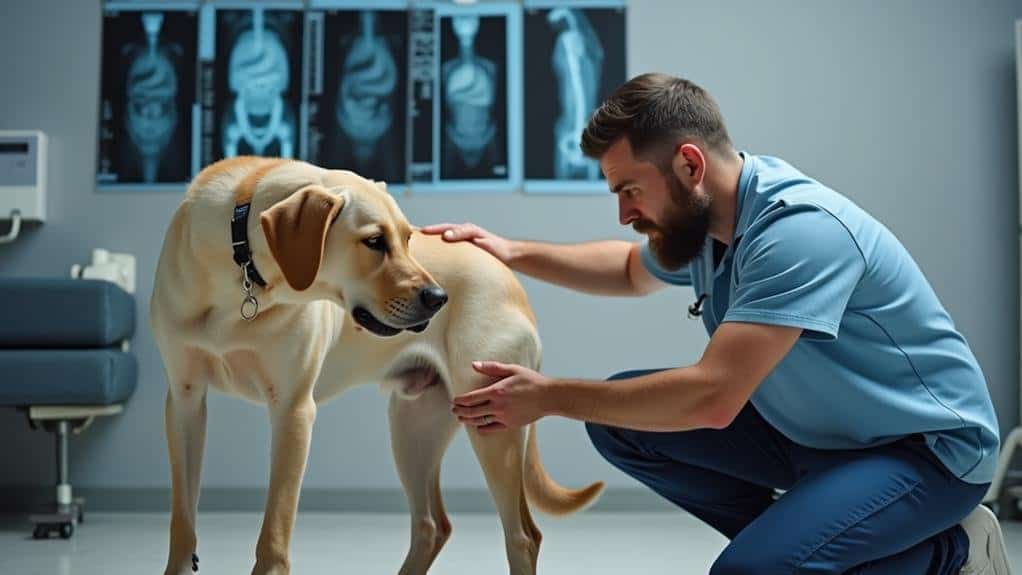Your dog’s rectal bleeding could be due to various causes, ranging from minor issues like anal gland problems or dietary changes to more serious conditions such as infections, parasites, or tumors.
Look for signs like visible blood in the stool, straining during defecation, or excessive licking of the anal area.
If the bleeding persists, is accompanied by other symptoms, or you notice bloody diarrhea, it’s essential to seek veterinary care immediately.
While some cases may resolve with simple home care, others require professional diagnosis and treatment.
Understanding the potential causes and symptoms can help you better navigate your dog’s health situation.
Common Causes of Rectal Bleeding

Why is your dog bleeding from its rear end? This alarming symptom can have several causes, ranging from minor issues to more serious conditions.
One common source of rectal bleeding in dogs is anal gland problems. These small sacs can become impacted or infected, leading to discomfort and bleeding.
Your dog’s GI tract might also be the culprit. Sudden dietary changes or ingestion of foreign objects can irritate the digestive system, resulting in bloody stool.
Additionally, intestinal parasites like hookworms and roundworms can cause inflammation and bleeding.
A more severe condition to watch for is Hemorrhagic Gastroenteritis (HGE). This acute illness presents with sudden bloody diarrhea and lethargy, requiring immediate veterinary attention.
Don’t delay if you suspect HGE, as it can be life-threatening.
Recognizing Symptoms

Recognizing the telltale signs of rectal bleeding in your dog is vital for timely intervention. The most obvious symptom is visible blood on your dog’s rear end or mixed in with their stool.
You’ll want to pay close attention to the color of the blood; bright red blood typically indicates fresh bleeding from the lower gastrointestinal tract.
Watch for your dog straining during defecation, which can signal discomfort related to bleeding or irritation. You might also notice your pet excessively licking their anal area, another sign of potential issues.
Keep an eye out for behavioral changes, such as lethargy or decreased appetite, as these can accompany rectal bleeding.
If you observe any of these symptoms, it’s important to monitor your dog closely. Additional signs like vomiting or indications of pain may point to a serious underlying condition that requires immediate veterinary attention.
When to Seek Veterinary Care

While recognizing symptoms is important, knowing when to seek veterinary care is equally critical. If you notice persistent anal bleeding in your dog, don’t wait to contact your veterinarian. This symptom requires immediate attention to determine the underlying cause and prevent potential complications.
Pay close attention to signs of pain or swelling around your dog’s anus, as these may indicate a serious issue that needs prompt evaluation.
Bloody diarrhea is another urgent symptom that necessitates an immediate visit to the vet. Your dog could be at risk of dehydration and other critical health concerns.
If you consistently see blood in your dog’s stool, schedule a veterinary appointment as soon as possible. This symptom could be indicative of various conditions, ranging from infections to tumors.
Don’t hesitate to seek immediate care if your dog exhibits additional symptoms like vomiting, weakness, or excessive licking of the anal area. These could be signs of severe health issues that require urgent attention.
Diagnostic Procedures for Anal Bleeding
To pinpoint the cause of your dog’s anal bleeding, veterinarians employ a range of diagnostic procedures. The process typically begins with a thorough physical exam at the veterinarian’s office.
This allows the vet to assess your dog’s overall health and identify any visible abnormalities that might be causing the anal bleeding.
Following the physical exam, your vet may recommend fecal tests to check for intestinal parasites or infections. Blood tests, including a complete blood count and chemistry panel, are often performed to evaluate your dog’s internal organs and detect underlying health issues that could be contributing to the bleeding.
In some cases, imaging techniques such as X-rays or ultrasounds may be necessary. These can help identify tumors, foreign objects, or other abnormalities within your dog’s gastrointestinal tract.
If the vet suspects tumors or polyps, they might recommend a biopsy to obtain a definitive diagnosis.
Treatment Options and Approaches
The road to recovery for a dog with anal bleeding begins with an accurate diagnosis.
Once your veterinarian has identified the underlying cause, they’ll recommend appropriate treatment options tailored to your dog’s specific health conditions.
For minor cases, your veterinarian may prescribe antibiotics to combat infections or anti-parasitic medications to eliminate infestations. They might also suggest dietary changes to soothe your dog’s gastrointestinal tract and reduce symptoms.
In more severe cases, such as hemorrhagic gastroenteritis, aggressive hydration through intravenous fluids is essential to prevent dehydration and stabilize your pet’s condition.
Some dogs may require surgical intervention for issues like tumors, polyps, or severe anal gland infections causing the bleeding. It’s important to follow your vet’s instructions carefully and attend all follow-up appointments to monitor your dog’s progress.
While professional care is significant, there are some home remedies you can implement to support your dog’s recovery. These may include providing a bland diet, ensuring plenty of fresh water, and keeping the anal area clean.
However, always consult your veterinarian before trying any home treatments, as they may not be suitable for all cases of anal bleeding in dogs.
Home Care and Management

Home care management plays an essential role in supporting your dog’s recovery from anal bleeding. When you notice your dog bleeding from his butt, it’s vital to monitor the situation closely.
Keep track of the frequency and amount of bleeding, along with any other symptoms like vomiting or changes in appetite. This detailed information will be invaluable to your veterinarian.
While awaiting professional help, you can implement some at-home care strategies. Switch your dog to a bland diet of boiled chicken and white rice to soothe his digestive tract. This can help reduce irritation in the gastrointestinal system.
If your pet shows discomfort around the anus, apply warm compresses to provide relief and reduce swelling. Ensure your dog stays hydrated, especially if he’s experiencing diarrhea.
However, consult your vet before giving oral fluids if severe symptoms are present.
Prevention Strategies

Five key prevention strategies can greatly reduce the risk of anal bleeding in your dog.
First, schedule regular veterinary check-ups to detect and manage potential health issues early. These visits allow your vet to identify and address problems before they lead to bleeding.
Second, maintain a consistent and balanced diet for your dog. Avoid sudden dietary changes, as they can cause gastrointestinal upset and potentially lead to anal bleeding. If you need to switch your dog’s food, do so gradually to support digestive health and minimize disturbances.
Third, prioritize routine anal gland maintenance. Regular checks and expressions can prevent impaction or infection, common causes of bleeding from the anal area. Your vet can show you how to perform this task or do it for you during check-ups.
Fourth, administer parasite prevention medications as recommended by your veterinarian. These treatments help eliminate intestinal parasites that may cause blood in your dog’s stool.
Long-Term Health Considerations

Building on these prevention strategies, it’s important to contemplate long-term health factors that can impact your dog’s risk of anal bleeding. Regular veterinary check-ups are essential for monitoring your pet’s overall health and detecting potential issues early. These visits allow your vet to assess your dog’s anal gland health and screen for other conditions that could lead to rectal bleeding.
Maintaining a balanced diet tailored to your dog’s specific needs is fundamental for long-term digestive health. A proper diet can help prevent gastrointestinal issues and reduce the risk of complications that may result in bleeding.
Additionally, keeping your dog at a healthy weight through appropriate nutrition and exercise can minimize the likelihood of anal gland problems and other health complications.
Don’t forget the importance of routine parasite prevention. Intestinal parasites can contribute to gastrointestinal bleeding and other digestive disorders, so staying on top of preventative treatments is crucial.
Frequently Asked Questions
Why Is My Dog Pooping Liquid Blood?
Your dog’s liquid blood stool could be due to various issues like hemorrhagic gastroenteritis, parasites, or inflammatory bowel disease. It’s a serious symptom that requires immediate veterinary attention. Don’t delay, as rapid dehydration can occur.
What Can I Do if My Dog Is Bleeding From His Private Area?
If your dog’s bleeding from his private area, don’t panic. You should immediately call your vet and schedule an appointment. Meanwhile, monitor the bleeding’s severity, note any additional symptoms, and avoid home remedies. Keep your dog calm and comfortable.
Why Does My Dog Keep Leaking Blood?
Your dog’s persistent blood leakage could be due to various issues like anal gland problems, infections, or gastrointestinal disorders. It’s essential you consult a vet immediately, as this symptom can indicate serious conditions requiring prompt medical attention.
Can Dogs Survive Melena?
Yes, dogs can survive melena if treated promptly. You’ll need to act quickly and get your dog to a vet immediately. With proper diagnosis and treatment, many dogs recover fully from the underlying causes of melena.
Conclusion
You’ve learned about the various causes of rectal bleeding in dogs and how to recognize the symptoms. Remember, it’s essential to seek veterinary care promptly if you notice any unusual bleeding. With proper diagnosis and treatment, most cases can be managed effectively. By following prevention strategies and maintaining regular check-ups, you’ll help guarantee your dog’s long-term health. Stay vigilant, and don’t hesitate to consult your vet if you’re concerned about your furry friend’s well-being.

